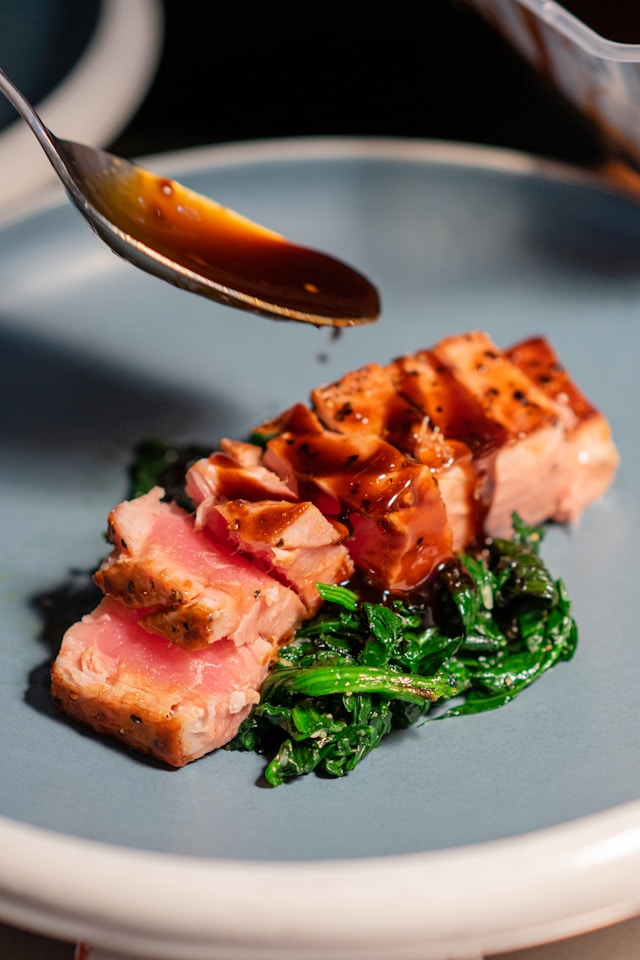Teriyaki Sauce
There are so many teriyaki sauce recipes out there. Most of them have lots of ingredients including dry ingredients like garlic, onions, and sugar. Even brown sugar!!!
It’s not that complicated.
It is three ingredients. Some will have two + sugar which kind of makes sense if you can’t find a specific item. Some even have three + sugar, which is a lot of sugar.
In short, they are typical Americanized recipes which is not what I want. Sugar is in everything in America and along with other simple carbs are a huge reason why obesity is a serious issue in the US and not Japan or most other Asian countries.
Adding insult to injury, these Americanized recipes are far more work.
I looked around a lot to find something closer to real teriyaki and I couldn’t find an actual recipe and that is because it really isn’t needed.
From what I could gather, and I do not speak or read Japanese is that teriyaki is two words. Teri, meaning gloss and yaki meaning something close to grill.
The three ingredients and why they are used:
Sake: This is a rice wine brewed from rice with the bran removed. It is closer to beer, not wine, despite the higher alcohol content compared to beer. It is around 15%. It contains an amino acid from the rice protein called umami(actually it is glutamic acid). Umami is also a word for a savory taste, that taste is what we want for our teriyaki sauce. There are many varieties of sake, and I am not sure what type is the best to use. I just used what I could find without going on a long search and it worked out well, but I bet there are better out there to use.
Soy sauce: This probably needs no introduction. It is brewed from fermented soybean paste. There are different types of soy sauce and the taste varies. In my normal Asian recipes, I use a brand from China. It is mild and far less salty. For this, I used a Japanese soy sauce. There is Kikkoman, a very old company. But, what you find in the US is made in the US and I suspect it is very different from what is available from Japan. After some searching in the Asian stores I found this great import called Kishibori Shoyu. It is very strong! They claim it is milder than most which makes me fear trying other Japanese soy sauce.
Mirin: This is a sweet cooking wine. Real mirin has no sugar added. This is why you might find recipes with sake, soy sauce and sugar. The sugar occurs naturally from the process of making the wine. But, adding processed sugar is unhealthier. Adding mirin and sugar is madness. Adding brown sugar is just plain weird as brown sugar is basically processed white sugar + molasses. I could only find Kikkoman Aji Mirin. Aji means taste in Japanese, so I think it is “tastes like mirin”, so not really mirin? I am not sure. I need to look harder for just mirin. It still worked pretty well. It also made me feel better about not using American-made Kikkoman soy sauce.
Edit: I finally found real mirin and it makes a huge difference.
Once you have these three ingredients, place a sauce pot on the stove and set it to medium heat. The goal is reduce the water and burn off the alcohol leaving the good parts behind. I reduced it roughly 50% and my condiment squeeze bottle holds two cups so I put 4 combined cups of ingredients in the pot.
The ratio is very simple 2:1:1 - 2 parts sake, 1 part soy sauce and 1 part mirin. I am still playing around with ratios to improve it, but this is very good.
Let it simmer until it reduces, and it will thicken up a bit. It won’t be like you added a cornstarch slurry or anything. It is more like a thin glaze. I stirred it every 2-3 minutes and took roughly an hour.
This is a finishing glaze, you won’t want to add it until the end. Otherwise, the sugar in it could caramelize or worse. Add it in to your chicken, fish, pork, vegetables, tofu, or whatever in the last few minutes of cooking.
The only thing I would use it as a marinade in is my teriyaki jerky.

Comments powered by Disqus.